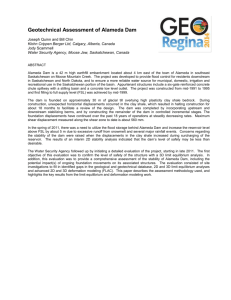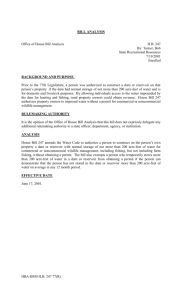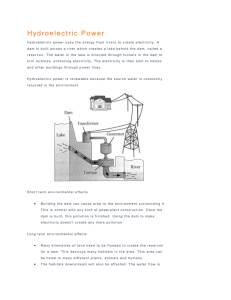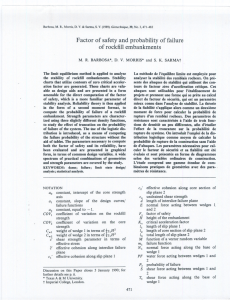BEHAVIOR OF THE XINGÓ CONCRETE FACE ROCKFILL DAM
advertisement
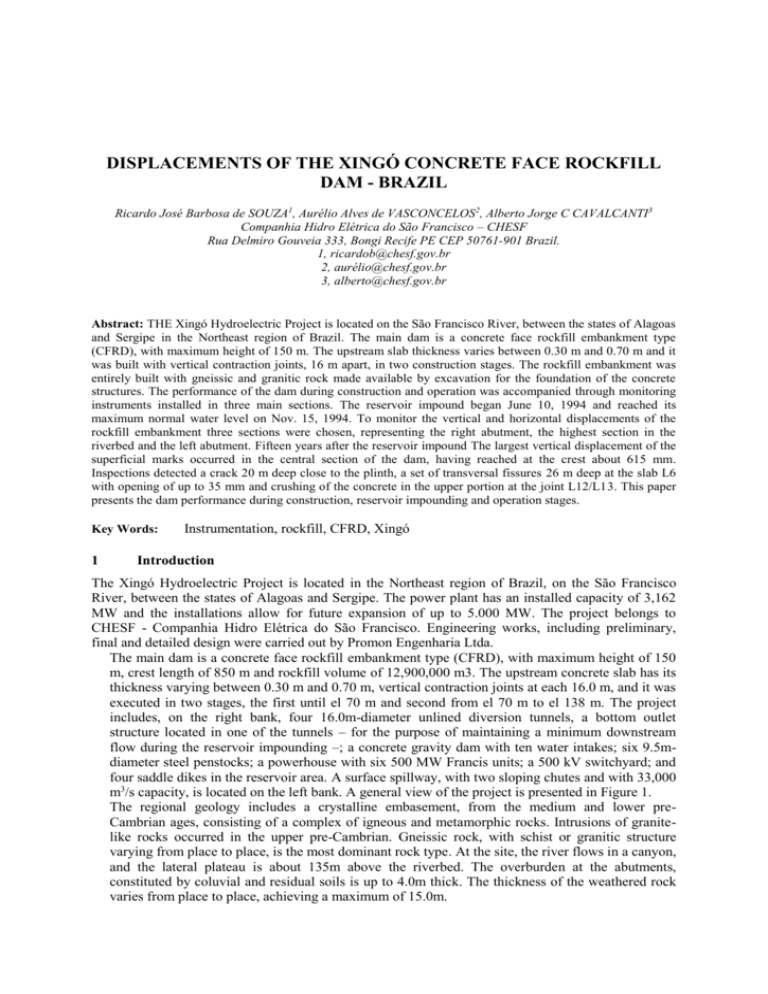
DISPLACEMENTS OF THE XINGÓ CONCRETE FACE ROCKFILL DAM - BRAZIL Ricardo José Barbosa de SOUZA1, Aurélio Alves de VASCONCELOS2, Alberto Jorge C CAVALCANTI3 Companhia Hidro Elétrica do São Francisco – CHESF Rua Delmiro Gouveia 333, Bongi Recife PE CEP 50761-901 Brazil. 1, ricardob@chesf.gov.br 2, aurélio@chesf.gov.br 3, alberto@chesf.gov.br Abstract: THE Xingó Hydroelectric Project is located on the São Francisco River, between the states of Alagoas and Sergipe in the Northeast region of Brazil. The main dam is a concrete face rockfill embankment type (CFRD), with maximum height of 150 m. The upstream slab thickness varies between 0.30 m and 0.70 m and it was built with vertical contraction joints, 16 m apart, in two construction stages. The rockfill embankment was entirely built with gneissic and granitic rock made available by excavation for the foundation of the concrete structures. The performance of the dam during construction and operation was accompanied through monitoring instruments installed in three main sections. The reservoir impound began June 10, 1994 and reached its maximum normal water level on Nov. 15, 1994. To monitor the vertical and horizontal displacements of the rockfill embankment three sections were chosen, representing the right abutment, the highest section in the riverbed and the left abutment. Fifteen years after the reservoir impound The largest vertical displacement of the superficial marks occurred in the central section of the dam, having reached at the crest about 615 mm. Inspections detected a crack 20 m deep close to the plinth, a set of transversal fissures 26 m deep at the slab L6 with opening of up to 35 mm and crushing of the concrete in the upper portion at the joint L12/L13. This paper presents the dam performance during construction, reservoir impounding and operation stages. Key Words: 1 Instrumentation, rockfill, CFRD, Xingó Introduction The Xingó Hydroelectric Project is located in the Northeast region of Brazil, on the São Francisco River, between the states of Alagoas and Sergipe. The power plant has an installed capacity of 3,162 MW and the installations allow for future expansion of up to 5.000 MW. The project belongs to CHESF - Companhia Hidro Elétrica do São Francisco. Engineering works, including preliminary, final and detailed design were carried out by Promon Engenharia Ltda. The main dam is a concrete face rockfill embankment type (CFRD), with maximum height of 150 m, crest length of 850 m and rockfill volume of 12,900,000 m3. The upstream concrete slab has its thickness varying between 0.30 m and 0.70 m, vertical contraction joints at each 16.0 m, and it was executed in two stages, the first until el 70 m and second from el 70 m to el 138 m. The project includes, on the right bank, four 16.0m-diameter unlined diversion tunnels, a bottom outlet structure located in one of the tunnels – for the purpose of maintaining a minimum downstream flow during the reservoir impounding –; a concrete gravity dam with ten water intakes; six 9.5mdiameter steel penstocks; a powerhouse with six 500 MW Francis units; a 500 kV switchyard; and four saddle dikes in the reservoir area. A surface spillway, with two sloping chutes and with 33,000 m3/s capacity, is located on the left bank. A general view of the project is presented in Figure 1. The regional geology includes a crystalline embasement, from the medium and lower preCambrian ages, consisting of a complex of igneous and metamorphic rocks. Intrusions of granitelike rocks occurred in the upper pre-Cambrian. Gneissic rock, with schist or granitic structure varying from place to place, is the most dominant rock type. At the site, the river flows in a canyon, and the lateral plateau is about 135m above the riverbed. The overburden at the abutments, constituted by coluvial and residual soils is up to 4.0m thick. The thickness of the weathered rock varies from place to place, achieving a maximum of 15.0m. Figure 1. General view The foundation of the dam is of gneissic rocks, with structure sometimes schistous, sometimes granitic. The plinth is 0.5 m thick and variable width ranging from 4.0 m to 7.7 m and fixed in unaltered rock through 32 mm anchors at each 1.7 m. The upstream concrete slab has its thickness varying between 0.30 m and 0.70 m, vertical contraction joints at each 16.0 m, and it was executed in two stages, the first until el 70 m and second from el 70 m to el 138 m. A general view of the project is presented in Figure 1. 2 Rockfill features The rockfill embankment was entirely built with gneissic and granitic rock made available by excavation from the foundation of the concrete structures. The rockfill was in general founded on rock, after removal of the small overburden layer, in both abutments. At the riverbed, some sand deposits were left in place, but sand removal was carried out in the upstream and downstream regions of the embankment foundation. The construction of the dam was concluded in the first half of 1994 and the reservoir filling occurred from 10/June/94 to 15/Nov/94. The features and the zoning of the main dam are presented below and in Figure 2. Zone I, beneath the upstream concrete slab, has a variable width, from 6.0 m at the lowest foundation level to 4.0m at the crest. The width is doubled at the contact with both abutments. The material for Zone I was obtained by grizzling, 4" bars spacing, weathered rock available from the superficial portion of the rock excavations. The material is impermeable to semi permeable, with 35% to 60% in weight passing nº 4 sieve and 4% to 12% passing in the nº 200 sieve. It was compacted in 0.4 m layers with 6 passes of a 6-ton vibratory roller. Zone II, a transition for Zone I, has a constant width of 4.0m and is flared to 8.0m at the contact with the foundation. The material for Zone II is selected fine rockfill with a maximum diameter of 0.4m. The material has 35% to 70% in weight passing the 1" sieve and 3% to 8% passing the nº 200 sieve. It was compacted in 0.4m thick layers, with 6 passes of a 10-ton vibratory roller. Zone III corresponds to the upstream third and consisted of unaltered rockfill, compacted in 1.0m thick layers, with 4 passes of a 10-ton vibratory roller, applying150 liters of water per cubic meter of rockfill. The material presented up to 40% passing in the 25mm sieve and up to 3% passing in the # 200 sieve. Figure 2. Main section with rockfill zoning of the dam Zone IV, corresponding to the downstream portion, consisted of unselected rockfill, compacted in 2.0m thick layers, with 4 roller passes, without addition of water. Weathered rock, available from the upper portion of the spillway excavation, was used mainly in the left abutment and partially in the riverbed portion of the embankment. The material presented from 15% to 60% passing in the 25 mm sieve and 2% to 7% passing in the # 200 sieve. Figure 2 shows the geometry of the dam and the zoning of the rockfill. 3 Displacements monitoring design To monitor the vertical and horizontal displacements of the rockfill embankment three sections were chosen, representing the right abutment, the highest section in the riverbed and the left abutment, corresponding to Stations 40+00, 49+00 and 62+00. The instrumentation of the upstream slab concentrated on the observation of the differential displacements between the slab and the plinth, the opening of the joints between slabs in the area of the abutments, and the observation of the temperatures and stresses. After the reservoir impound an additional instrumentation was installed to monitor the area where cracks were appeared in the slabs. Settlements of the rockfill embankment are being monitored through settlement hydraulic cells, of the Swedish box type. Additionally, two magnetic settlement gauges were installed on riverbed, one in Zone III, other in Zone IV with plates at each 4 m and 6 m respectively. The horizontal displacements are measured in the same positions of the settlement cells, through multiple rod extensometers with KM horizontal stems. Superficially, the horizontal and vertical displacements are being measured through topographical marks in the top of the slab and slopes including marks in the instrumentation reading cabins. The global control of the seepage flow through the dam and foundation is made by a triangular flow meter, MV01, installed in the top of the downstream cofferdam. The Figures 3, 4 and 5 shows the instrumentation of the rockfill embankment in the right bank, in the riverbed (highest section) and in the left bank. Figure 3. Typical section and instrumentation plan on the right bank Figure 4. Typical section and instrumentation plan on the riverbed Figure 5. Typical section and instrumentation plan on the left bank 4 Monitoring instrumentation data 4.1 Construction Period The settlements measured during the construction period, in the highest section of the dam, Station 49, reached the values of 1700 mm in Zone III and 2900 mm in Zone IV. Considering such settlements recorded by instrumentation and performing a retro-analysis, the following average deformability moduli were obtained for the rockfill embankment, Souza et al [5]: Zone III - E = 32 Mpa Zone IV - E = 20 Mpa The maximum horizontal displacement observed in section 49, at the end of the construction period, was of 590 mm measured at the top and 530 mm measured inside the embankment. The following occurrences were verified during the construction of the dam, regarding the behavior of the rockfill embankment: At the beginning of the construction 2nd stage of the slab, between el 70 m and el 135 m, voids were observed, of the order of some centimeters, between the upstream slab and the rockfill embankment of Zone I, at el 70 m, top of the 1st stage. Those voids were filled with mortar and cement grout, before the construction of the slab, above el 70 m. Some superficial cracks were observed in the exposed face of Zone I, before the construction of the upstream slab second stage, between el 70 m and el 135 m, around el 115 m at the left abutment. Cracks were filled with fine sand applied with water and the slope face was recomposed with material from Zone I. 4.1 Reservoir impound and Operation Periods The reservoir impound started on June 10, 1994, with water level at el 40 m, increasing quickly to el 120 m on June 16 and to el 134 m on July 13, where it remained stable until November. The filling restarted on November 11 and the reservoir reached its maximum level at el 138 m on November 15, 1994 and since then it has been oscillating between 138 m and 137.5 m. To monitor the behavior during the reservoir impound and operation periods, the displacements of the construction phase were reset. The displacements measurements of CFRD during the 15 years of operation, including the period of filling the reservoir, are presented in Figures 6 to 11. 5 Measurements analysis From the measurements analysis, fifteen years after the reservoir impound, we noted the following observations and occurrences: The largest vertical displacement of the superficial marks(surface benchmarks) occurred in the central section of the dam, station 49 - Figure 7, having reached at the crest about 615 mm at MS11 and 515 mm at the mark of the reading cabin CL-6 at El. 110 m; The maximum vertical displacement measured inside the rockfill by settlement cells was 550 mm, El. 110 m - CR18 - Station 49, and the maximum measured in Zone I was 520 mm, El. 85 m CR14, Figure 7, central section of the dam; The maximum horizontal displacement was of 385 mm at MS22 at the crest, and internally it was of 310 mm at KM6P1 in the central section of the CFRD, Figure 10; During the first year of operation the behavior of the dam, in terms of displacements and seepage flow, was perfectly normal, being observed a tendency of stabilization of the measurements; cr19 cl08 cr20 ms16 cr21 ms19 cr22 ms24 Figure 8. STATION 62 – Vertical displacements cr23 cl 06 cl07 14/09/09 14/09/09 18/03/09 19/09/08 23/03/08 25/09/07 29/03/07 cl02 cr09 18/03/09 19/09/08 23/03/08 25/09/07 cl 05 29/03/07 30/09/06 03/04/06 05/10/05 08/04/05 cl01 cr08 30/09/06 03/04/06 05/10/05 08/04/05 10/10/04 13/04/04 16/10/03 19/04/03 cr05 cr07 10/10/04 cl 04 cr 18 13/04/04 16/10/03 19/04/03 21/10/02 21/10/02 24/04/02 26/10/01 29/04/01 31/10/00 cr03 cr06 24/04/02 cr 14 cr 17 26/10/01 29/04/01 31/10/00 04/05/00 06/11/99 10/05/99 11/11/98 cr02 ms21 04/05/00 cr 11 cr 15 06/11/99 10/05/99 11/11/98 15/05/98 16/11/97 20/05/97 21/11/96 25/05/96 27/11/95 31/05/95 02/12/94 05/06/94 vertical displacement (mm) cr01 ms07 15/05/98 16/11/97 cr 10 ms 22 20/05/97 21/11/96 25/05/96 27/11/95 31/05/95 02/12/94 05/06/94 vertical displacement (mm) 14/09/09 18/03/09 19/09/08 23/03/08 25/09/07 29/03/07 30/09/06 03/04/06 05/10/05 08/04/05 10/10/04 13/04/04 16/10/03 19/04/03 21/10/02 24/04/02 26/10/01 29/04/01 31/10/00 04/05/00 06/11/99 10/05/99 11/11/98 15/05/98 16/11/97 20/05/97 21/11/96 25/05/96 27/11/95 31/05/95 02/12/94 05/06/94 vertical displacement (mm) 650,0 600,0 550,0 500,0 450,0 400,0 350,0 300,0 250,0 200,0 150,0 100,0 50,0 0,0 cl03 Figure 6. STATION 40 – Vertical displacements 650,0 600,0 550,0 500,0 450,0 400,0 350,0 300,0 250,0 200,0 150,0 100,0 50,0 0,0 ms 11 Figure 7. STATION 49 – Vertical displacements 650,0 600,0 550,0 500,0 450,0 400,0 350,0 300,0 250,0 200,0 150,0 100,0 50,0 0,0 KM7P1 MS16 KM7P2 MS19 KM7P3 MS24 KM8P1 KM8P2 Figure 11. STATION 62 –Horizontal displacements CL07 14/09/09 18/03/09 19/09/08 23/03/08 25/09/07 cl02 CL08 14/09/09 18/03/09 KM5P3 19/09/08 23/03/08 25/09/07 KM5P2 29/03/07 29/03/07 30/09/06 03/04/06 05/10/05 cl01 KM3P2 30/09/06 03/04/06 05/10/05 KM5P1 08/04/05 08/04/05 10/10/04 13/04/04 16/10/03 KM2P2 KM3P1 10/10/04 13/04/04 16/10/03 KM4P4 MS11 19/04/03 19/04/03 21/10/02 24/04/02 26/10/01 29/04/01 KM2P1 KM2P3 21/10/02 24/04/02 26/10/01 KM4P3 cl06 29/04/01 31/10/00 31/10/00 04/05/00 06/11/99 10/05/99 11/11/98 KM1P3 KM1P4 04/05/00 KM4P2 cl05 06/11/99 10/05/99 11/11/98 15/05/98 KM4P1 cl04 15/05/98 16/11/97 20/05/97 21/11/96 KM1P2 MS21 16/11/97 20/05/97 21/11/96 25/05/96 MS22 KM6P2 25/05/96 27/11/95 31/05/95 02/12/94 05/06/94 KM1P1 MS07 27/11/95 31/05/95 02/12/94 05/06/94 Horizontal displacement (mm) Horizontal displacement (mm) 14/09/09 18/03/09 19/09/08 23/03/08 25/09/07 29/03/07 30/09/06 03/04/06 05/10/05 08/04/05 10/10/04 13/04/04 16/10/03 19/04/03 21/10/02 24/04/02 26/10/01 29/04/01 31/10/00 04/05/00 06/11/99 10/05/99 11/11/98 15/05/98 16/11/97 20/05/97 21/11/96 25/05/96 27/11/95 31/05/95 02/12/94 05/06/94 Horizontal displacement (mm) 390,0 360,0 330,0 300,0 270,0 240,0 210,0 180,0 150,0 120,0 90,0 60,0 30,0 0,0 cl03 Figure 9. STATION 40 –Horizontal displacements 390,0 360,0 330,0 300,0 270,0 240,0 210,0 180,0 150,0 120,0 90,0 60,0 30,0 0,0 KM6P1 Figure 10. STATION 49 –Horizontal displacements 390,0 360,0 330,0 300,0 270,0 240,0 210,0 180,0 150,0 120,0 90,0 60,0 30,0 0,0 The specific vertical displacements, registered by the surface benchmarks, were practically the same in the three sections in November of 1995, one year after the filling of the reservoir. In November 2008 the increment of the vertical displacements in related to November 1995 was of 40% at Station 40, 49% at Station 49 and 90% at Station 62, see Table 1. These values indicate the influence of the rockfill wetting by the seepage flow at the left abutment that even affected the central section of the dam. 6 Station. Height (m) Vertical displacement Nov 1995 (mm) Vertical displacement Nov 2008 (mm) Specific Vertical displacement Nov1995 (%) Specific Vertical displacement Nov2008 (%) RATIO 2008/1995 (%) 40 113 277 388 0,2451 0,3434 40,10 49 150 385 575 0,2567 0,3833 49,31 62 86 257 489 0,2988 0,5686 Table 1: Specific vertical displacements 1 year and 14 years after filling 90,29 Cracks in the upstream slab Between September and November of 1995, the instruments installed at Station 62 registered a fast intensification of the vertical displacements, with increase of speeds of up to ten times, Figure 12. The increase of the settlements speed coincides with the increase of the seepage flow and with the observation of damages in the slab. Station 62 - Vertical Displacements MS e CL - Flow MV ms16 ms19 ms24 MV01 29-Mar-07 25-Sep-07 30-Sep-06 5-Oct-05 3-Apr-06 8-Apr-05 10-Oct-04 16-Oct-03 13-Apr-04 21-Oct-02 19-Apr-03 26-Oct-01 24-Apr-02 29-Apr-01 4-May-00 0,00 31-Oct-00 20,00 0,0 6-Nov-99 40,00 50,0 11-Nov-98 60,00 100,0 10-May-99 80,00 150,0 16-Nov-97 100,00 200,0 15-May-98 120,00 250,0 21-Nov-96 140,00 300,0 20-May-97 160,00 350,0 27-Nov-95 180,00 400,0 25-May-96 200,00 450,0 2-Dec-94 220,00 500,0 31-May-95 240,00 550,0 Flow (l/s) cl08 600,0 5-Jun-94 Settlement (mm) cl07 Figure 12: Total flow and vertical displacements, MS and CL – Station 62 The intensification of the flow through the upper part of the left abutment would have drained the water towards the river channel and to downstream, due to the conformation of the foundation, causing rockfill wetting and the sudden increment of vertical and horizontal displacements. Divers, down to a depth of 40m, firstly performed the investigations of the upstream slab, at the left abutment area, in 1996. These inspections detected a crack 20 m deep close to the plinth in the base of slab L5, a set of transversal fissures 26 m deep at the slab L6 with opening of up to 35 mm and crushing of the concrete in the upper portion at the joint L12/L13, Figure 13. Figure 13: Location of damages at the left abutment slabs In a second stage the underwater inspection with divers and robot identified several points of suction in the cracks of the slab. Three crack treatment campaigns were accomplished in these places through the placing of fine silty sand in 30-kg bags applied with the aid of divers. The sand, with granulometry of 99.8% #1.2 mm; 99.5% #0.6 mm; 90.4% #0.3 mm; 26.1 #0.15 mm, in terms of percentage that passes through sieve was thrown directly on the cracks, until clogging and stopping the suction. The cracks in the slabs are in the same area where the surface cracks happened in Zone I at the end of the construction period. The causes are associated essentially to the protuberance of the rock massive in the upstream side creating a strong unevenness between Zones III and IV areas of the dam. The treatment with placing of silty sand directly on the points of suction of the slab was effective in the reduction of the flow. In consequence a reduction was observed in the rates of the measured displacements at the left abutment. 6 Conclusions The main conclusions regarding the performance of the concrete face rockfill dam are: The sudden increase in the vertical displacements, starting from September 1995, was probably caused by the infiltrations through the cracks in slabs L4 / L5 and L6, resulting in the wetting of the rockfill of Zone IV of the dam, especially at the left abutment; The specific vertical displacements ranged from 0.34% to 0.56% in November 2008 and still do not show a trend of stabilization; The long term slow deformation of the rockfill embankment varied ranged from 40% to 90% since November 1995 up to November 2008; The follow-up through the instrumentation of the dam was crucial to detect and correct the problems; The cracks in the slabs of the left abutment are associated with the foundation topography, with the plinth much more elevated in relation to the downstream toe of the dam; The treatment with silty sand was effective in the reduction of the flow through the slab cracks. In consequence a reduction was observed in the rates of the measured displacements at the left abutment; 7 Acknowledgements The authors wish to thank Companhia Hidro Elétrica do São Francisco - CHESF for their support and the authorization to publish the data presented in this work. 8 Bibliography [1] Eigenheer, L.P, Vasconcelos, A.A., Souza, R.J.B. Cavalcanti, A.J.C.T. (2000) – “Xingó concrete face rockfill dam”, XX ICOLD International Congress on Large Dams, Beijing - China. [2] Souza, R.J.B., Cavalcanti, A.J.C.T., Vasconcelos, A.A., Silva, P. N., (2007) – “Performance of the Xingó concrete face rockfill dam”, III Symposium on CFRD Dams honoring J. Barry Cooke, Florianópolis – SC- Brazil. [3] Souza, R.J.B., Silva, S.A., Silveira, J.F.A. (1999) – “Xingó concrete face rockfill dam behavior of the dam on the left abutment”, II Symposium on CFRD, Florianópolis – SC- Brazil.

